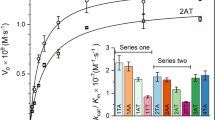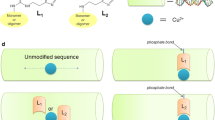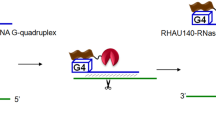Abstract
Specific recognition by EcoRV endonuclease of its cognate, sharply bent GATATC site at the center TA step occurs solely via hydrophobic interaction with thymine methyl groups. Mechanistic kinetic analyses of base analog-substituted DNAs at this position reveal that direct readout provides 5 kcal mol–1 toward specificity, with an additional 6–10 kcal mol–1 arising from indirect readout. Crystal structures of several base analog complexes show that the major-groove hydrophobic contacts are crucial to forming required divalent metal-binding sites, and that indirect readout operates in part through the sequence-dependent free-energy cost of unstacking the center base-pair step of the DNA.
This is a preview of subscription content, access via your institution
Access options
Subscribe to this journal
Receive 12 print issues and online access
$189.00 per year
only $15.75 per issue
Buy this article
- Purchase on Springer Link
- Instant access to full article PDF
Prices may be subject to local taxes which are calculated during checkout






Similar content being viewed by others
References
Rhodes, D., Schwabe, J.W., Chapman, L. & Fairall, L. Towards an understanding of protein–DNA recognition. Phil. Trans. Royal Soc. B 351, 501–509 (1996).
Seeman, N.C., Rosenberg, J.M. & Rich, A. Sequence-specific recognition of double helical nucleic acids by proteins. Proc. Natl. Acad. Sci. USA 73, 804–808 (1976).
Otwinowski, Z. et al. Crystal structure of trp repressor/operator complex at atomic resolution. Nature 335, 321–329 (1988).
Koudelka, G.B., Harrison, S.C. & Ptashne, M. Effect of noncontacted bases on the affinity of 434 operator for 434 repressor and Cro. Nature 326, 886–888 (1987).
Rosenberg, J.M. Structure and function of restriction endonucleases. Curr. Opin. Struct. Biol. 1, 104–113 (1991).
Lesser, D.R., Kurpiewski, M.R., Waters, T., Connolly, B.A. & Jen-Jacobson L. Facilitated distortion of the DNA site enhances EcoRI endonuclease–DNA recognition. Proc. Natl. Acad. Sci. USA 90, 7548–7552 (1993).
Draper, D.E. Protein–DNA complexes: the cost of recognition. Proc. Natl. Acad. Sci. USA 90, 7429–7430 (1993).
Jen-Jacobson, L. Structural-perturbation approaches to thermodynamics of site-specific protein–DNA interactions. Meth. Enz. 259, 305–344 (1995).
Schildkraut, I., Banner, C.D.B., Rhodes, C.S. & Parekh, S. The cleavage site for the restriction enzyme EcoRV is 5'-GAT/ATC-3'. Gene 27, 327–329 (1984).
Roberts, R.J. & Halford, S.E. In Nucleases (eds Linn, S.M., Lloyd, R.S. & Roberts, R.J.) 35–88 (Cold Spring Harbor Laboratory Press, Cold Spring Harbor, New York; 1993).
Vipond, I.B. & Halford, S.E. Structure–function correlation for the EcoRV restriction enzyme: from non-specific binding to specific DNA cleavage. Mol. Microbiol. 9, 225–231 (1993).
Engler, L.E., Welch, K.K. & Jen-Jacobson, L. Specific binding by EcoRV endonuclease to its DNA recognition site GATATC. J. Mol. Biol. 269, 82–101 (1997).
Winkler, F.K. et al. The crystal structure of the EcoRV endonuclease and of its complexes with cognate and non-cognate DNA fragments. EMBO J. 12, 1781–1795 (1993).
Kostrewa, D. & Winkler, F.K. Mg2+ binding to the active site of EcoRV endonuclease—A crystallographic study of complexes with substrate and product DNA at 2 Å resolution. Biochemistry 34, 683–696 (1995).
Perona, J.J. & Martin, A.M. Conformational transitions and structural deformability of EcoRV restriction endonuclease revealed by crystallographic analysis. J. Mol. Biol. 273, 207–225 (1997).
Horton, N.C. & Perona, J.J. Role of protein-induced bending in the specificity of DNA recognition: crystal structure of EcoRV endonuclease complexed with d(AAAGAT) + d(ATCTT). J. Mol. Biol. 277, 779–787 (1998).
Cheng, X., Balendiran, K., Schildkraut, I. & Anderson, J.E. Structure of PvuII endonuclease with cognate DNA. EMBO J. 13, 3927–3935 (1994).
Wah, D.A., Hirsch, J.A., Dorner, L.F., Schildkraut, I. & Aggarwal, A.K. Structure of the multimodular endonuclease FokI bound to DNA. Nature 388, 97–100 (1997).
Newman, M., Strzelecka, T., Dorner, L.F., Schildkraut, I. & Aggarwal, A.K. Structure of BamHI endonuclease bound to DNA: partial folding and unfolding on DNA binding. Science 269, 656–663 (1995).
Vipond, I.B. & Halford, S.E. Specific DNA recognition by EcoRV restriction endonuclease induced by calcium ions. Biochemistry 34, 1113–1119 (1995).
Lesser, D.R., Kurpiewski, M.R. & Jen-Jacobson, L. The energetic basis of specificity in the EcoRI endonuclease–DNA interaction. Science 250, 776–786 (1990).
Fersht, A.R. Enzyme structure and mechanism (W.H. Freeman & Co., New York; 1985).
Alves, J., Selent, U. & Wolfes, H. Accuracy of the EcoRV restriction endonuclease: binding and cleavage studies with oligodeoxynucleotide substrates containing degenerate recognition sequences. Biochemistry 34, 11191–11197 (1995).
Taylor, J.D. & Halford, S.E. Discrimination between DNA sequences by the EcoRV restriction endonuclease. Biochemistry 28, 6198–6207 (1989).
Lipanov, A., Kopka, M.L., Kaczor-Grzeskowiak, M., Quintana, J. & Dickerson, R.E. Structure of the B-DNA decamer C-C-A-A-C-I-T-T-G-G in two different space groups: conformational flexibility of B-DNA. Biochemistry 32, 1373–1389 (1993).
Xuan, J.C. & Weber, I.T. Crystal structure of a B-DNA dodecamer containing inosine, d(CGCIAATTCGCG), at 2.4 A resolution and its comparison with other B-DNA dodecamers. Nucleic Acids Res. 20, 5457–5464 (1992).
Selent, U. et al. A site-directed mutagenesis study to identify amino acid residues involved in the catalytic function of the restriction endonuclease EcoRV. Biochemistry 31, 4808–4815 (1992).
Horton, N.C., Newberry, K.J. & Perona, J.J. Metal ion-mediated substrate-assisted catalysis in type II restriction endonucleases. Proc. Natl. Acad. Sci. USA, 95, 13489–13494 (1998).
Wenz, C., Jeltsch, A. & Pingoud, A. Probing the indirect readout of the restriction enzyme EcoRV. J. Biol. Chem. 271, 5565–5573 (1996).
Hancox, E.L. & Halford, S.E. Kinetic analysis of a mutational hot spot in the EcoRV restriction endonuclease. Biochemistry 36, 7577–7585 (1997).
Goodsell, D.S., Kaczor-Grzeskowiak, M. & Dickerson, R.E. The crystal structure of CCATTAATGG: implications for bending of B-DNA at TA steps. J. Mol. Biol. 239, 79–96 (1994).
El Hassan, M.A. & Calladine, C.R. Propeller-twisting of base-pairs and the conformational mobility of dinucleotide steps in DNA. J. Mol. Biol. 259, 95–103 (1996).
Hunter, C.A. Sequence-dependent DNA structure. The role of base stacking interactions. J. Mol. Biol. 230, 1025–1054 (1993).
Hunter, C.A. & Lu, X-J. DNA base-stacking interactions: a comparison of theoretical calculations with oligonucleotide X-ray crystal structures. J. Mol. Biol. 265, 603–619 (1997).
Santa Lucia, J., Jr., Allawi, H.T. & Seneviratne, P.A. Improved nearest-neighbor parameters for predicting DNA duplex stability. Biochemistry 35, 3555–3562 (1996).
Doktycz, M.J., Morris, M.D., Dormady, S.J., Beattie, K.L. & Jacobson, K.B. Optical melting of 128 octamer DNA duplexes. J. Biol. Chem. 270, 8439–8445 (1995).
Jen-Jacobson, L. Protein–DNA recognition complexes: conservation of structure and binding energy in the transition state. Biopolymers 44, 153–180 (1997).
Aggarwal, A.K. Crystallization of DNA binding proteins with oligodeoxynucleotides. Meth. Enz. 1, 83–90 (1990).
Surby, M.A. & Reich, N.O. Facilitated diffusion of the EcoRI DNA methyltransferase is described by a novel mechanism. Biochemistry 35, 2209–2217 (1996).
van Zoelen, E.J.J. Analysis of receptor binding displacement curves by a nonhomologous ligand, on the basis of an equivalent competition principle. Anal. Biochem. 200, 393–399 (1992).
Sack, J.S. CHAIN—A crystallographic modelling program. J. Mol. Graphics 6, 224–225 (1988).
Brunger, A.T., Kuriyan, J. & Karplus, M. Crystallographic R-factor refinement by molecular dynamics. Science 235, 458–460 (1987).
Parkinson, G. et al. New parameters for the refinement of nucleic acid-containing structures. Acta Crystallogr. D 52, 57–64 (1996).
Baldwin, G.S., Vipond, I.B. & Halford, S.E. Rapid reaction analysis of the catalytic cycle of the EcoRV restriction endonuclease. Biochemistry 34, 705–714 (1995).
Newman, P.C., Williams, D.M., Cosstick, R., Seela, F. & Connolly, B.A. Interaction of the EcoRV restriction endonuclease with the deoxyadenosine and thymidine bases in its recognition hexamer d(GATATC). Biochemistry 29, 9902–9910 (1990).
Evans, S.V. SETOR: hardware lighted three-dimensional solid model representations of macromolecules. J. Mol. Graphics 11, 134–138 (1993)..
Acknowledgements
We thank N. Horton for insightful discussions and J. Kohn for assistance with protein purification. This work was supported by grants from the NIH and ACS-PRF (to J.J.P.).
Author information
Authors and Affiliations
Corresponding author
Rights and permissions
About this article
Cite this article
Martin, A., Sam, M., Reich, N. et al. Structural and energetic origins of indirect readout in site-specific DNA cleavage by a restriction endonuclease. Nat Struct Mol Biol 6, 269–277 (1999). https://doi.org/10.1038/6707
Received:
Accepted:
Issue Date:
DOI: https://doi.org/10.1038/6707
This article is cited by
-
TRX-LOGOS - a graphical tool to demonstrate DNA information content dependent upon backbone dynamics in addition to base sequence
Source Code for Biology and Medicine (2015)
-
Protein-DNA docking with a coarse-grained force field
BMC Bioinformatics (2012)



